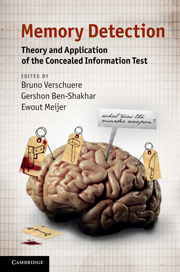Book contents
- Frontmatter
- Contents
- List of figures
- List of tables
- Notes on contributors
- Acknowledgments
- Part I Introduction
- Part II The laboratory: theoretical and empirical foundations of the Concealed Information Test
- 2 Detecting concealed information using autonomic measures
- 3 Detecting concealed information in less than a second: response latency-based measures
- 4 P300 in detecting concealed information
- 5 Detecting of deception and concealed information using neuroimaging techniques
- 6 New and old covert measures in the Concealed Information Test
- 7 Theory of the Concealed Information Test
- Part III Field applications of concealed information detection: promises and perils
- Part IV Conclusions
- Index
- References
3 - Detecting concealed information in less than a second: response latency-based measures
Published online by Cambridge University Press: 05 June 2012
- Frontmatter
- Contents
- List of figures
- List of tables
- Notes on contributors
- Acknowledgments
- Part I Introduction
- Part II The laboratory: theoretical and empirical foundations of the Concealed Information Test
- 2 Detecting concealed information using autonomic measures
- 3 Detecting concealed information in less than a second: response latency-based measures
- 4 P300 in detecting concealed information
- 5 Detecting of deception and concealed information using neuroimaging techniques
- 6 New and old covert measures in the Concealed Information Test
- 7 Theory of the Concealed Information Test
- Part III Field applications of concealed information detection: promises and perils
- Part IV Conclusions
- Index
- References
Summary
Overview: Concealed information is typically assessed with physiological measures. To overcome the limitations of physiological measures, an assessment using response latencies has been proposed. At first sight, research findings on response latency-based concealed information tests seem inconsistent. Our procedural analysis of the various latency-based tests indicates that tests based on a manipulation of relevant stimulus-response compatibility, such as the oddball task (Farwell and Donchin, 1991; Seymour et al., 2000), have typically produced robust results. These results are promising, but need to be extended with research examining vulnerability to faking and performance under more realistic circumstances.
A wide range of physiological indices have been registered in order to detect concealed information: skin conductance, heart rate, respiration, pulse volume, facial temperature, event-related potentials, and cerebral blood oxygenation. Laboratory studies have typically produced large effect sizes, confirming the validity of concealed information measures that are based on these indices (Ben-Shakhar and Elaad, 2003; Gamer et al., 2008; Langleben et al., 2002; Rosenfeld, 2002). However, physiological measures have their limitations. First, none of these measures allows for perfect detection, leaving room for improvement. Second, certain functional characteristics of physiological indices (e.g., habituation, non-responding) can undermine the validity of concealed information tests, based on these indices. Third, all physiological measures require sophisticated and often expensive machinery. From this perspective, there may be merit in measures that are based on other types of indices.
- Type
- Chapter
- Information
- Memory DetectionTheory and Application of the Concealed Information Test, pp. 46 - 62Publisher: Cambridge University PressPrint publication year: 2011
References
- 32
- Cited by



